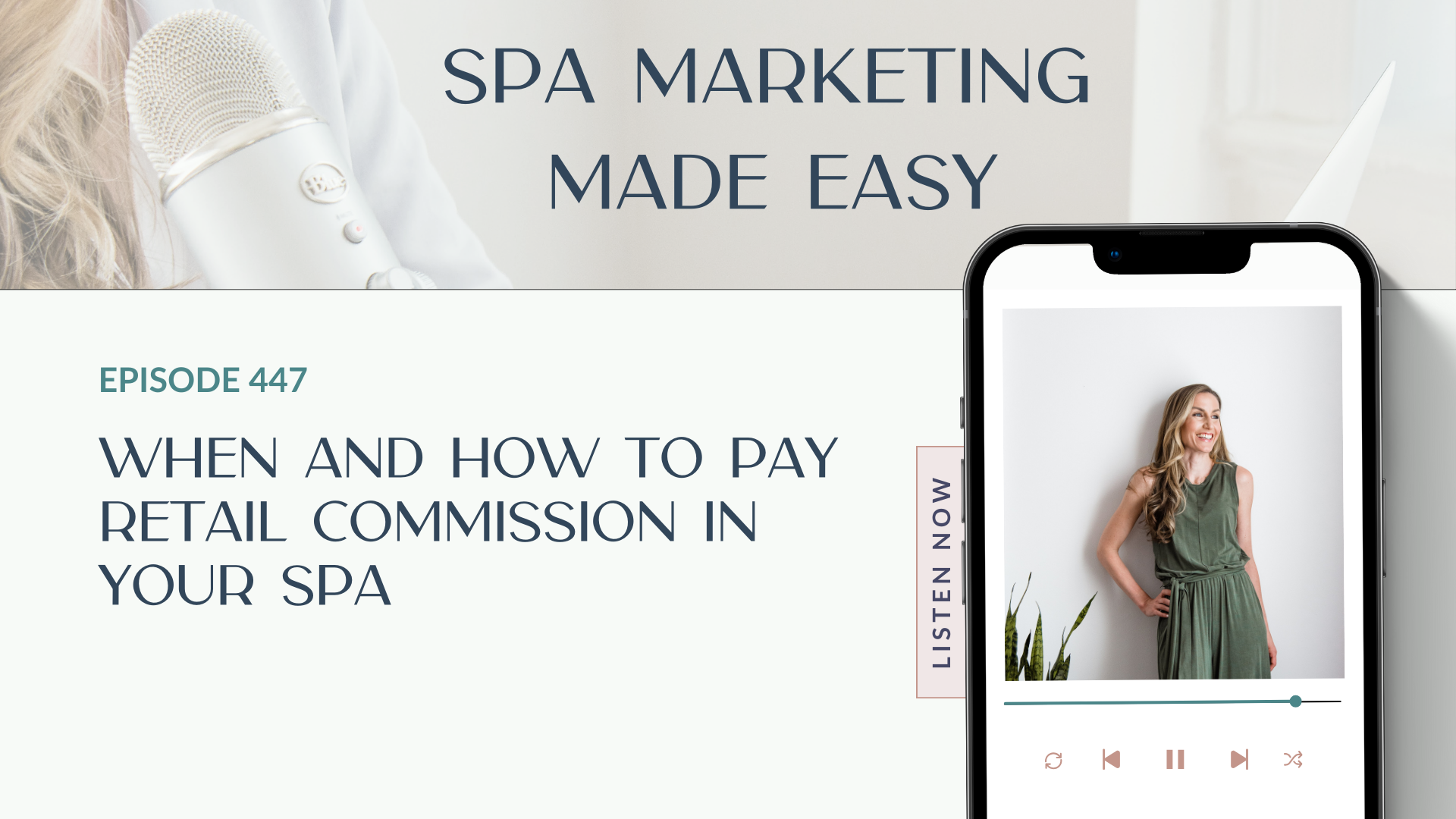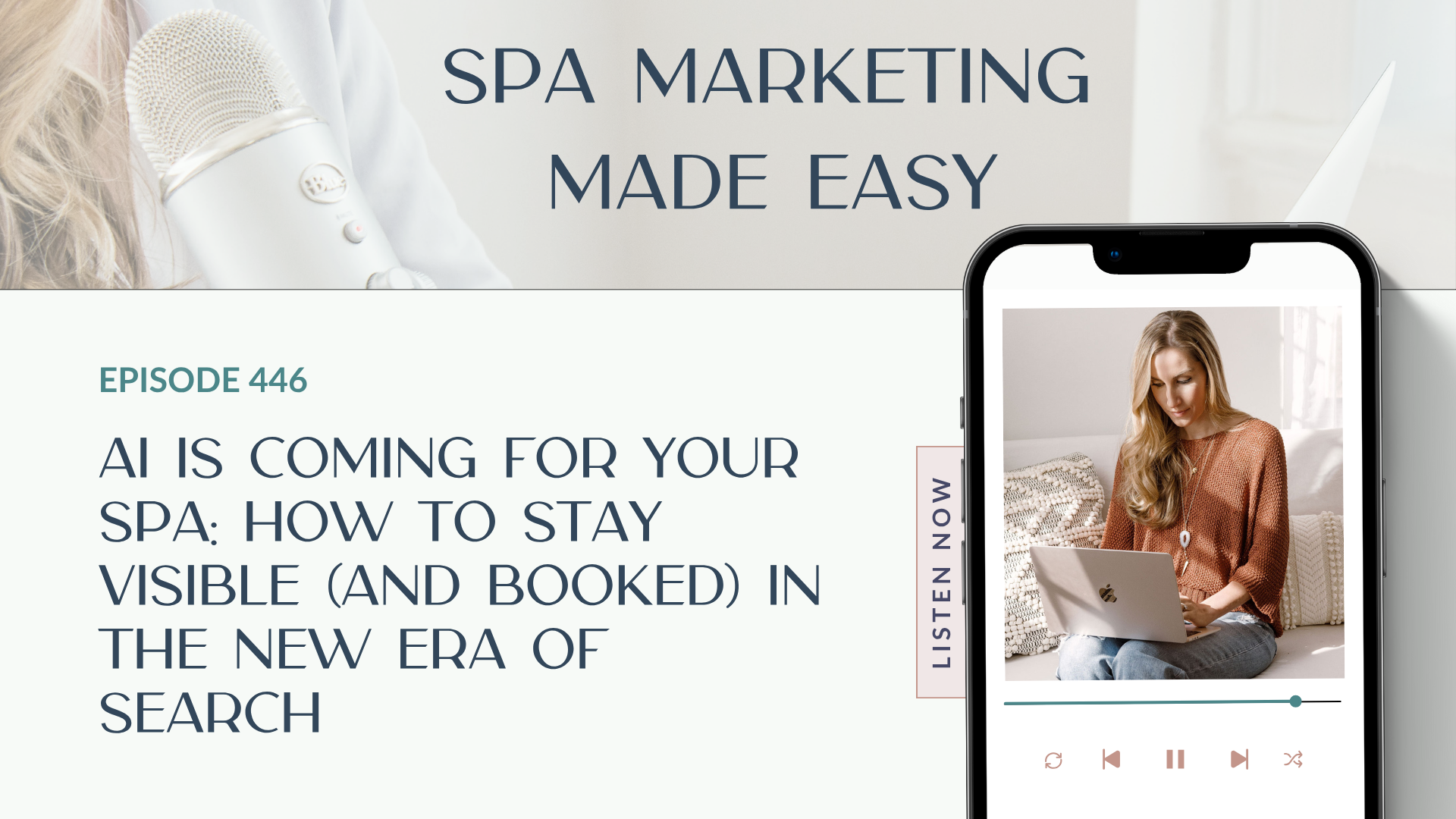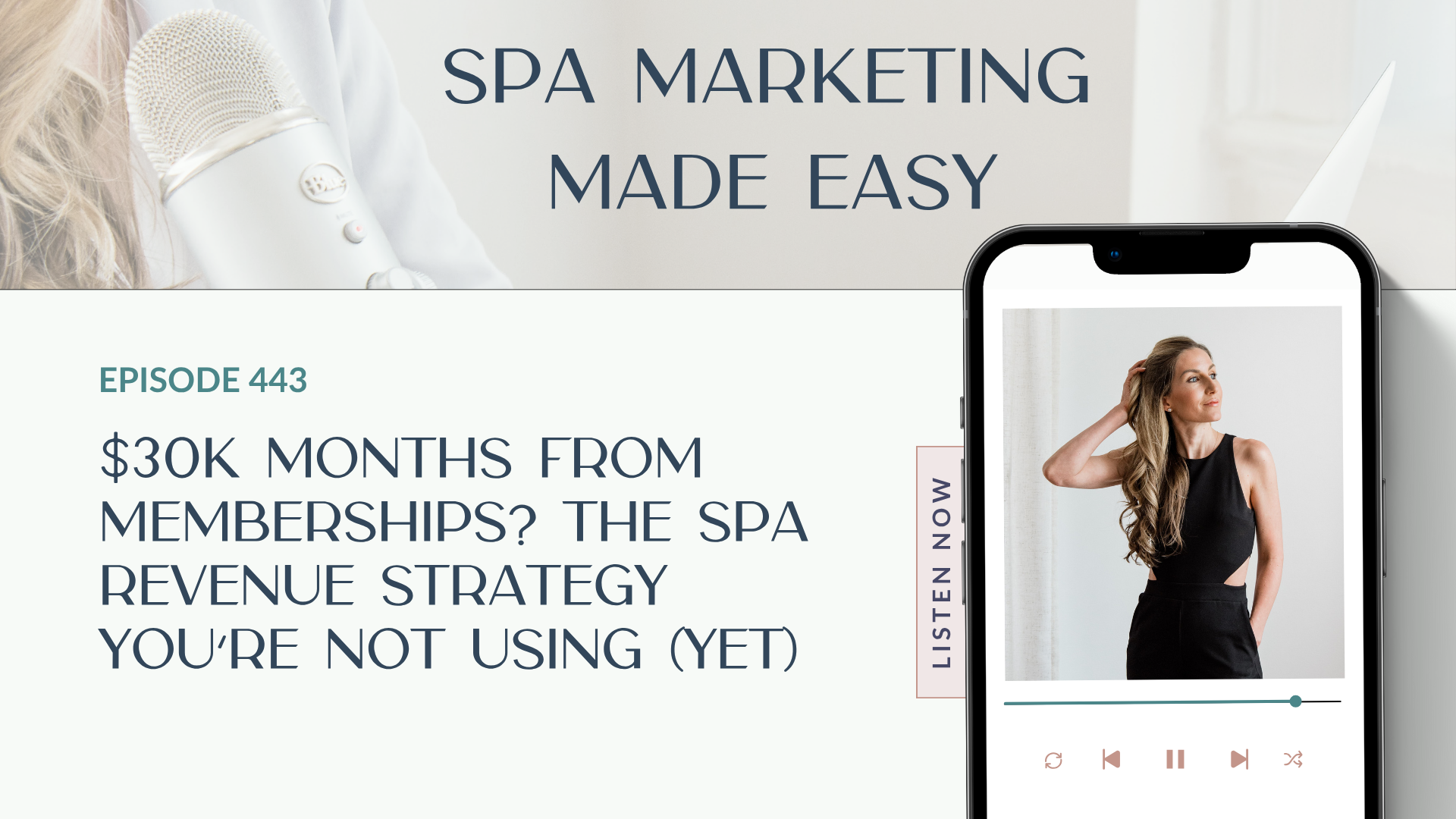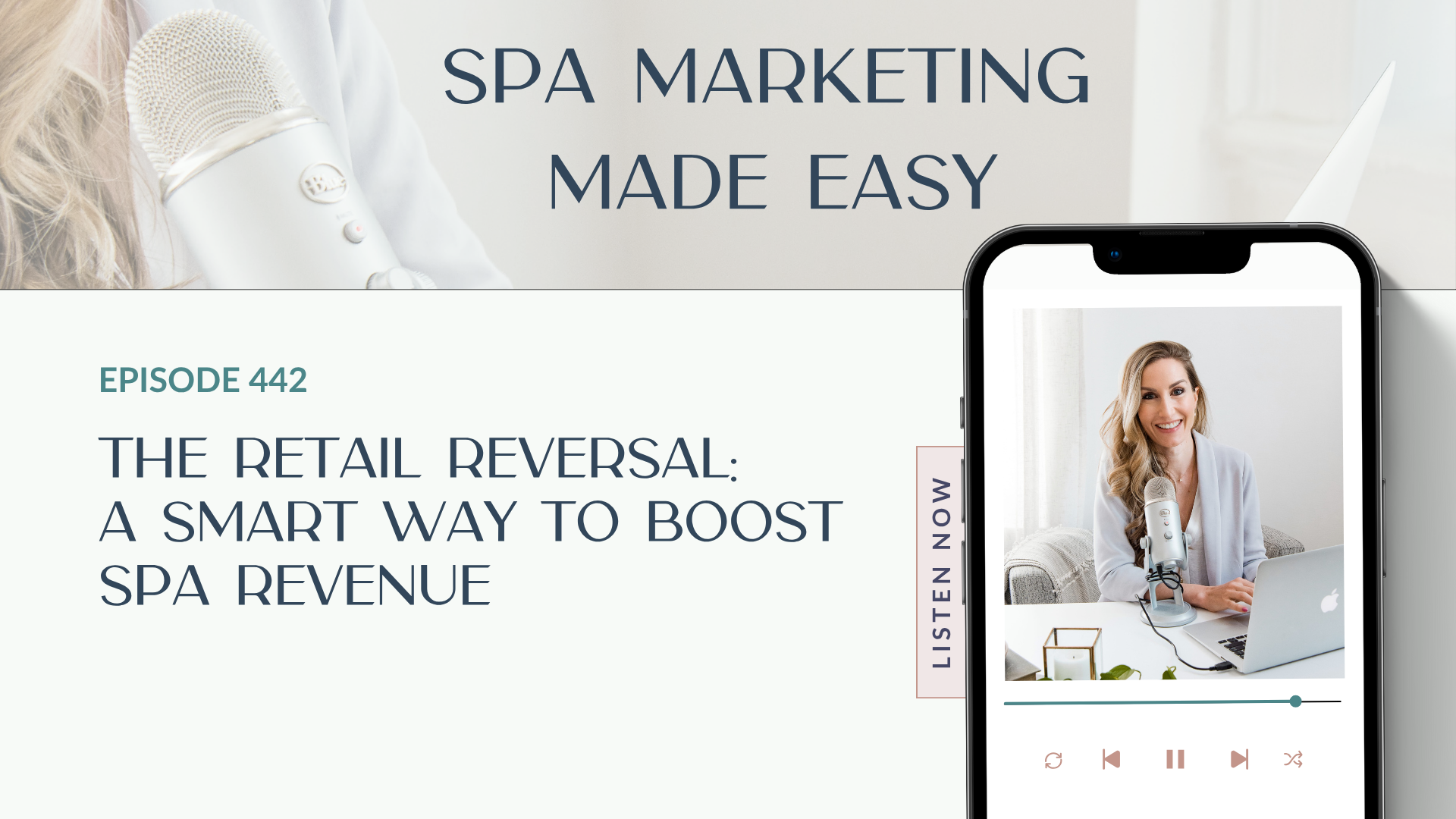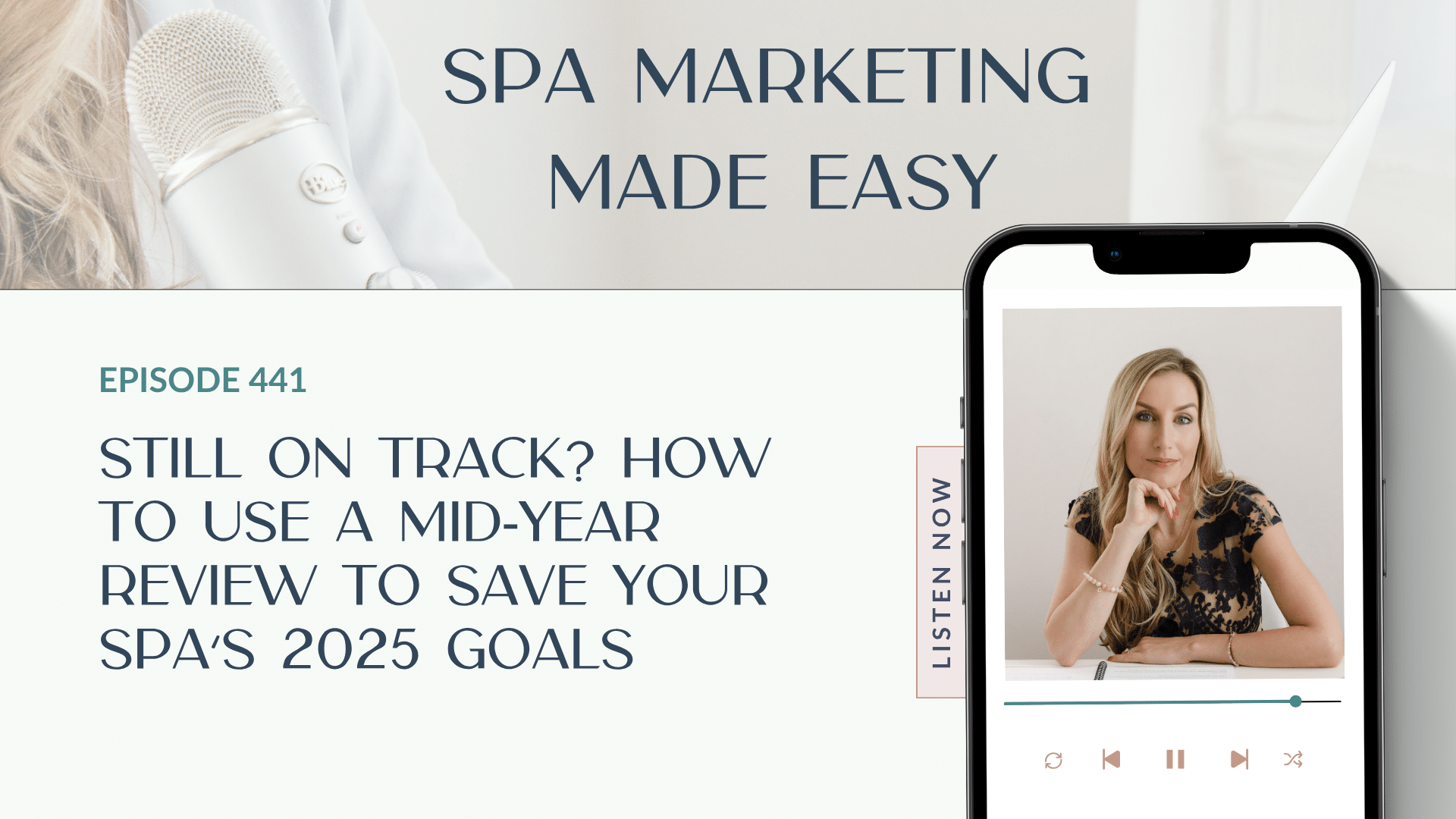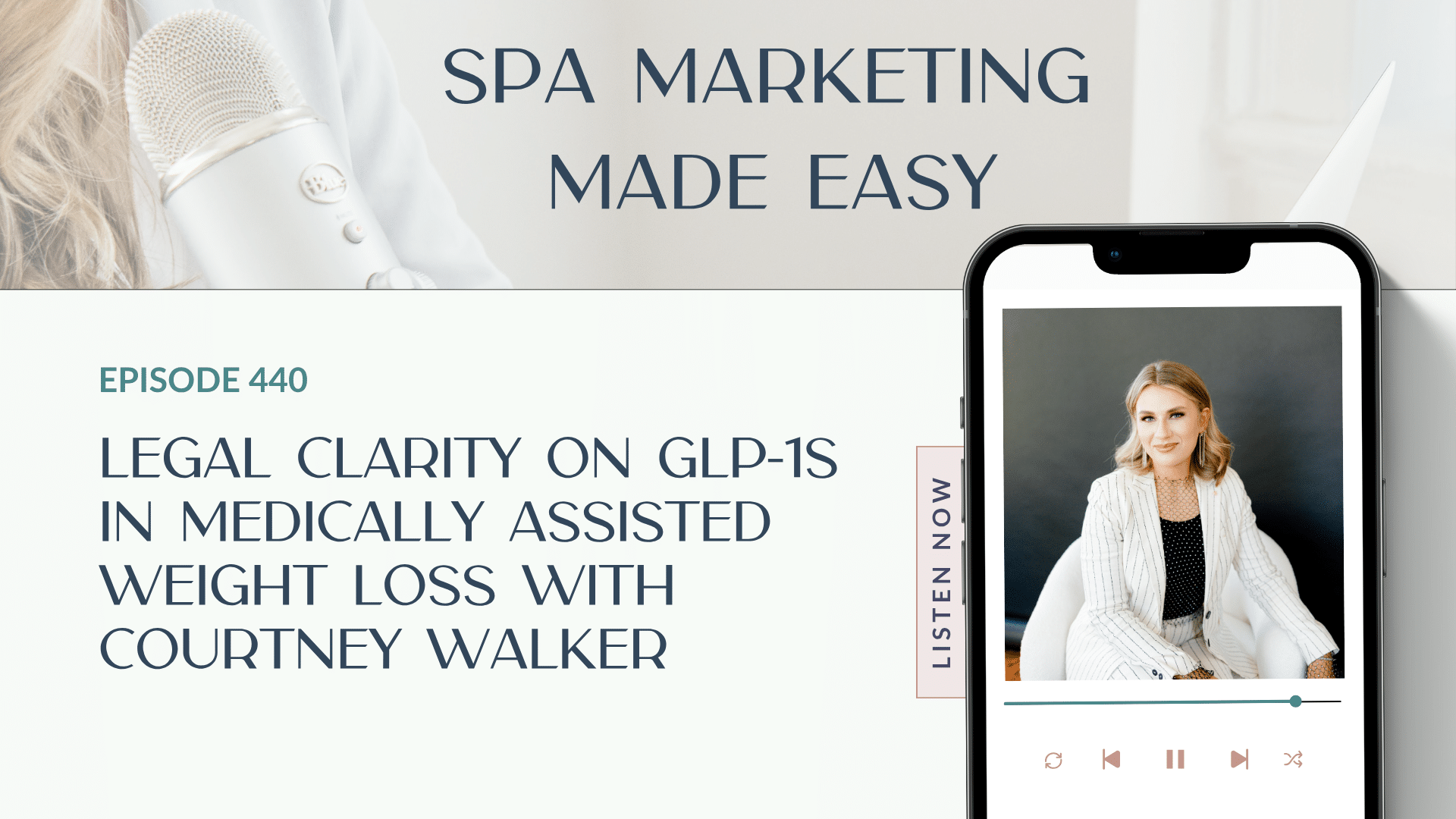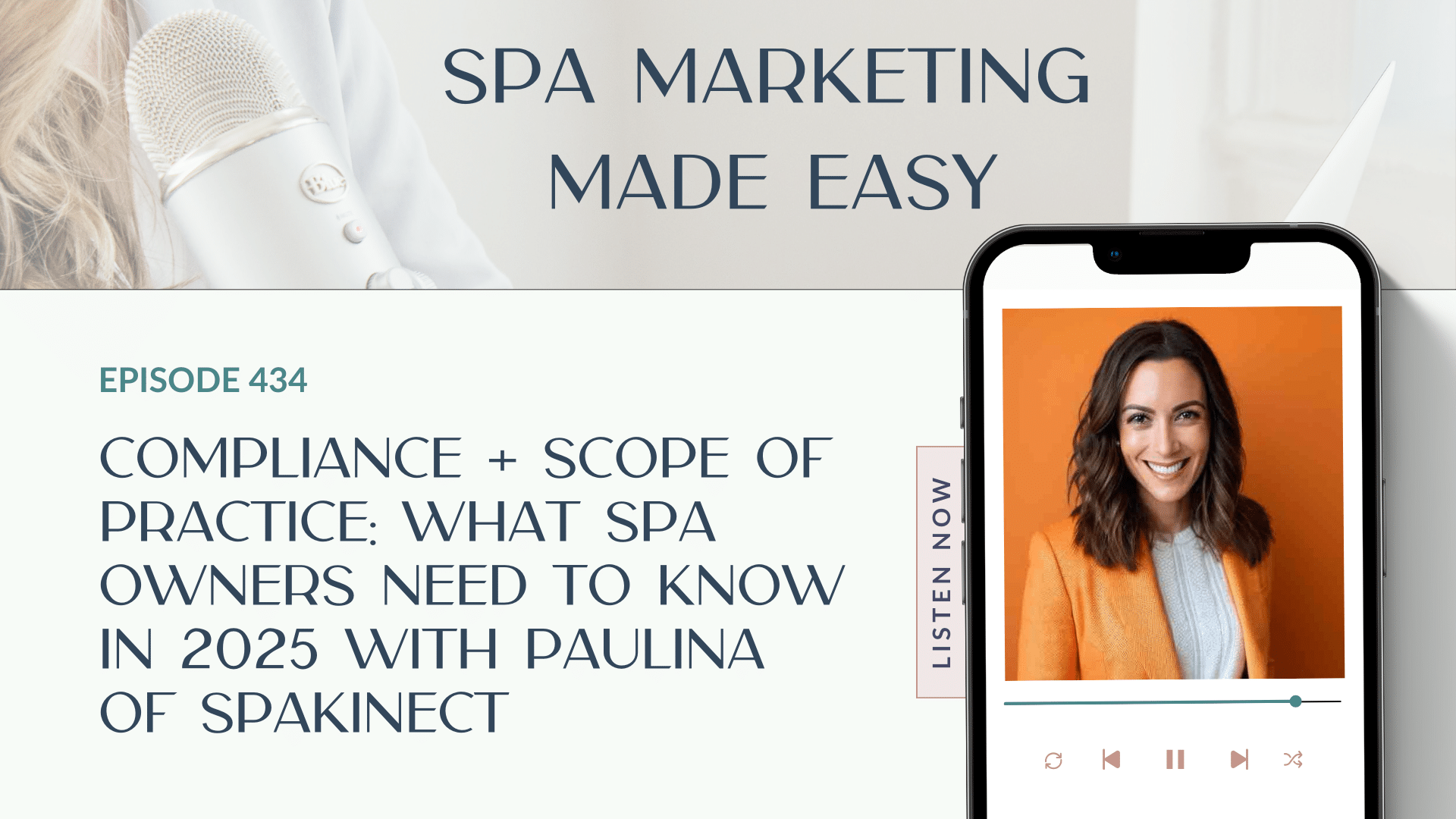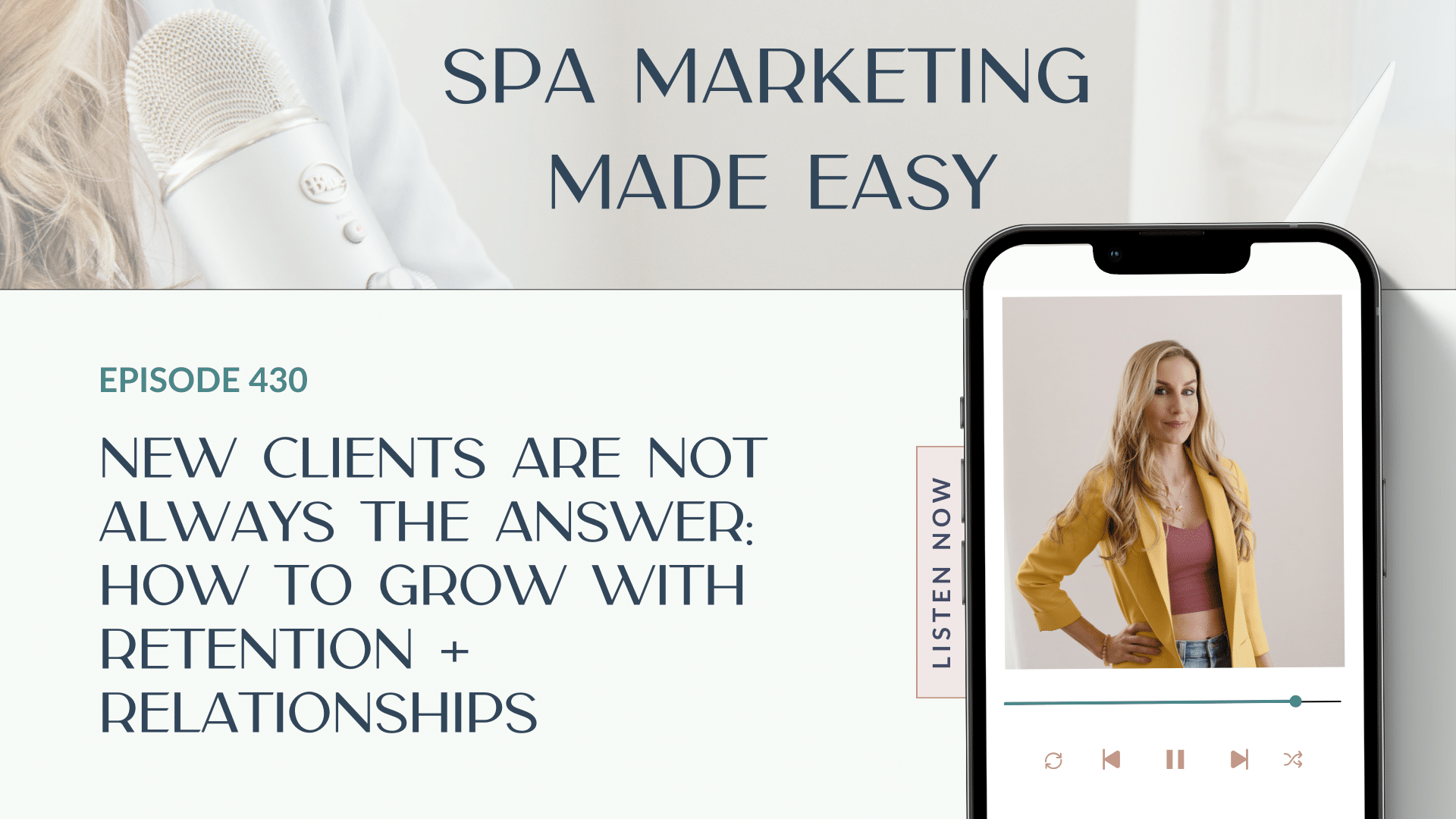Retail Isn’t Just Revenue – It’s Client Results, Team Buy-In, and Business Growth
If you’ve ever struggled with how to structure retail commissions in your spa, you’re not alone. The truth is, too many spa owners either avoid it altogether or implement policies that cause internal confusion, resentment, or worse – lost revenue.
In this episode of Spa Marketing Made Easy, I’m sharing everything I’ve learned over nearly two decades in the aesthetic industry about crafting a smart, sustainable retail commission structure that benefits your team, your clients, and your business.
Whether you’re running a solo practice with plans to grow or managing a multi-provider spa, you need a clear system that defines who earns commission, how much, and under what circumstances.
Let’s start by debunking the myth that retail is just “extra.” When your clients are sent home with high-quality skincare products that align with their treatments, they get better results. They’re more likely to rebook. They’re more loyal. And, according to a study by Millennium spa software, clients who purchase three or more products have a 90% chance of returning. That’s the kind of data we can’t ignore.
But here’s the deal: retail doesn’t sell itself, and it certainly doesn’t work without structure.
So, what’s the right way to do retail commission in your spa?
We begin by differentiating between front desk staff and providers. Front desk teams can absolutely earn a commission—but only on impulse purchases (think lip balms, sunscreen, travel sizes). A flat 10% is a good baseline. However, they should never recommend full skincare regimens unless they are trained providers who have evaluated the client’s skin.
Your estheticians, nurses, or injectors—the ones building full home care plans—are the ones who should earn commission on those more complex recommendations. But instead of offering a flat rate across the board, I recommend a tiered structure based on their retail-to-service ratio.
For example:
- Under 30% = 0% commission
- 30–39% = 10% commission
- 40–49% = 12% commission
- 50% or more = 15% commission
This incentivizes consistent performance, not just one-off wins. It also allows you to hold the line on profitability, even as you reward top-performing providers.
If you’re wondering how to define those retail-to-service benchmarks, look at the highest performer in your practice right now. Let their numbers set the top tier and work backwards. Or, if your team is new to retail culture, start with attainable targets and increment them by 5% every quarter to build momentum.
Another best practice? Delay commission for the first 90 days of employment. This “probation period” gives your new hires time to align with your culture, understand your protocols, and focus on learning – before earnings kick in. It’s also a great way to recoup some of the investment you make in onboarding and training.
But none of this works if you don’t have documentation. Who gets credit for a sale six months down the line? What if a client repurchases online? Who earns commission during a retail-heavy event?
If these questions aren’t clearly answered in your operations manual, employee handbook, or team training, you’re at risk of confusion and conflict.
That’s why this episode also includes a breakdown of common retail commission mistakes – like paying blindly, failing to create a standardized flow chart of product recommendations, or not assigning repurchase credit to the original provider within a reasonable timeframe.
When you get this right, retail becomes a triple win: your clients win with better results, your team wins with increased income potential, and your business wins with higher revenue and improved retention.
This is one of the most practical, powerful systems you can build into your spa today. Tune in, take notes, and then head into your next team meeting ready to lead with clarity and confidence.

Subscribe to Our Newsletter
Stay up-to-date with our email newsletter to receive important updates, news, and offers!
IG / @addoaesthetics
WEB / addoaesthetics.com
YOUTUBE / @addoaesthetics
LINKEDIN / @addoaesthetics
ABOUT THE SPA MARKETING MADE EASY HOST
About Your Host, Daniela Woerner
Daniela Woerner is the founder and CEO of Addo Aesthetics, a leading community for aesthetic professionals, and the creator of the Growth Factor® Framework—a proven system that has helped 582 six- and seven-figure spa owners scale their businesses with strategy and systems.
With nearly two decades in the aesthetics industry, Daniela has trained alongside top physician-dispensed brands, consulted with leading dermatologists, and helped thousands of spa professionals streamline their operations and maximize profitability.
Her mission? To transform overworked aestheticians into Spa CEOs—building a business and life they love with the strategic systems needed for long-term financial growth.
As the host of the Spa Marketing Made Easy podcast, Daniela brings expert insights, real-world strategies, and in-depth conversations to help spa owners elevate their marketing, optimize their operations, and create sustainable success. With over 400 published episodes, 1 million+ downloads, and a ranking in the top 1% of all podcasts worldwide, Spa Marketing Made Easy is the go-to resource for spa and aesthetic professionals looking to level up.
Tune in each week for actionable strategies, expert interviews, and inspiration to help you build a thriving, systemized, and scalable spa business!
PODCAST TRANSCRIPT:
Hello, my dears, and welcome back to another episode of Spa Marketing Made Easy. I am your host, Daniela. And gosh, I can’t even believe that I’m saying this. I’ve been in the industry for almost 20 years now, which feels like such a long time, and it feels like a flash in in the same way, sort of like parenting. You know, I feel like my daughter, it’s like, she’s eight already, and I’m like, how did that happen? But when I first started out of aesthetics, 11 years ago, I focused a lot on retail, and I actually started my first four years of the business consulting, and I worked a lot with the physician to spend skincare brands. I was doing trainings for aestheticians on increasing retail sales. I was speaking at the Lunch and Learn events all across the country. And then I was being hired by medical spas to come into their practices and do trainings specifically for their staff on how to increase retail. So retail is something that is near and dear to my heart.
I believe that it’s such an important part of having a spa and of your revenue streams for having a spa, not just to have the additional revenue coming in, but for the actual benefit of the patient, because they are going to have better results if they’re using high quality skincare at home, but not having a retail policy around commission for your staff can cause So many bumps in the road, and so what I want to do with this episode is really dive into retail commission in general. Okay, so who gets paid? How much should they earn? When do they earn it? What are the guidelines around this? This is something that I get asked all of the time.
So if you have a team, if you have a front desk in place, but you’re just really unsure how to structure your retail commission policy, this is going to be a great episode for you. Now, retail isn’t just cash, it is client transformation. Okay, when your patients or clients go home with the right products, they’re going to get better results. They’re going to recommend more people to you, they’re going to leave you reviews. They’re going to have more trust with you. They’ll be more loyal to you, right? And obviously, with all of that comes more revenue now millennium, which is a spa booking software, they did a study, and they said that if a client purchases three or more products from you, they have a 90% likelihood of coming back. That’s huge. That is so huge. So when you’re estheticians, when we’re looking at you know, how am I going to make sure that my books are full sell retail? We’ve got, we have data from Spa booking softwares that are showing this.
And I think there’s just a disconnect there, but it is such an important piece. You know, we get hung up as providers. And I’ve seen this over and over again. We have such close relationships with our patients and our clients. We don’t want to feel salesy. We don’t want to be pushy. But your clients and patients are using skincare.
They are they if they’re not purchasing it from you, they are purchasing it somewhere else. And we want to make sure that we are recommending what we believe is going to be the right home care regimen for them, the best home care regimen for them. It’s their choice if they purchase it or not, but it is your job to be able to make that recommendation. Okay. Now to give a little incentive to help our providers really see how important retail is. We want to make sure, as spa CEOs that we are incentivizing that. Okay, so I’m going to break this into different sections, so I want to talk about the front desk first, because, yes, I do believe that front desk should earn commission on products, but it should be a very specific set of products. Okay, so think impulse purchase like lip glosses or lip scrubs. You know those like silicone eye patches, travel sizes. If they want to add on some sunscreens, maybe grab a sunscreen for the kids, things like this. These are products that the front desk can recommend while checking a client out. And I would just have an across the board 10% commission rate, okay, but here’s where we need a front. Boundary your front desk, they’re not estheticians, and if they are estheticians, they’re not estheticians. Who have seen that patient’s skin in the room, looked at it under a light, and really have an understanding of what that particular patient’s goals are.
Okay. So the front desk is not responsible for recommending entire home care regimens that is going to belong to your providers, your aestheticians, your nurses, your injectors, okay? And one of the ways that we have our providers making recommendations that are aligned with your practice is to have a flow chart of standardized product recommendations. Okay? So we want to have the vitamin C that our practice believes in, the cleanser for oily skin, that our practice believes in, the cleanser for dry skin that our practice believes in.
So what we don’t want to have is four different vitamin C’s, right? That is cash on your shelves, and that is just waiting for confusion down the line. Okay? So when you have boundaries around what the front desk can offer and what your providers can offer, and then we have a standardization of what those offerings are. Your patient or client is going to get consistent recommendations. This is going to build trust with the brand. It’s going to reduce confusion, and it’s going to support retail growth across the board. One clear message coming out of your spa. Okay. Now this is actually something that’s really easy to create with chatGPT, and what I love about chatGPT is that you can dictate in there. So if you are a speak to think person like me, you just hit that microphone button and you talk to chat and say, here’s what I would recommend for this type of patient, here’s what I would recommend for this type of patient, here’s what I would recommend for this type of patient. And you’re going through based off of skin conditions, based off of the patient concerns.
Chat can organize all of that and create a really clear flow chart for you to use in your practice. Okay, so really, really great asset for you to have in your business. Now, again, our goal here is to have clear messaging across the board, so that a patient doesn’t get one recommendation from one provider and then a completely different recommendation from another that is going to break down trust real fast. Now, I’ve got a section in this episode that is common mistakes that spa owners make around retail. I’m going to get into that a little bit more down there. Okay, so let’s move into your providers. All right. So estheticians, nurses, we want to look at how we are going to structure the commissions that they’re going to be earning specifically on retail Okay, so side note here, the pay structure that we recommend here at auto esthetics is zero commission.
We actually recommend hourly pay on services, but for retail products, we do have a tiered commission structure, so there’s two there’s a separation between services and retail Okay, so what I’m talking about today is retail commission. Now your providers are responsible for creating the entire home care regimen for that patient, the plan, the recommendations, what the regimen is that needs to be documented in their chart, and it needs to be very clear so that the front desk should never deviate from that. Okay, so let’s say that you make an entire home care regimen recommendation. So you’ve got your AM, you’ve got your Pm, you’ve got all of your products, your cleanser, your toner, your antioxidant, your specialty product, your sunscreen, whatever it is that you’re recommended, you’re recommending, even if that patient only buys two or three products, we have the entire recommendation in there so that it’s easy to go back and see it’s documented that we talked about it, and if a patient calls to purchase something not on the same day that you had that service, it’s very easy for the front desk. It’s. Be able to understand what product it is that they need to purchase that was recommended by the provider that saw them. Okay, so let’s get into the actual commission structure. Now, we believe that commission should be paid. The level of commission should be paid based off of their retail to service ratio. So we’re looking at how much retail they sell compared to how many services they perform. Now, if you here’s the structure, and this is the this is the framework, there’s going to be some ups and downs based on your business model, but this is what we suggest. So if your retail to service is under 30% then you get zero commission. You don’t earn commission on products, because 30% is the the baseline.
This is the absolute minimum retail to service percentage that a provider should have in our practice, if you are between 30 to 39% retail to service, you get a 10% commission. If you are 40 to 49% commission or retail to service, you get a 12% commission. And if you are 50% or higher, you get 15% commission. Now that extra 5% commission is going to be made up for the people that are performing lower at the under 30% All right, now this model is rewarding consistency. It’s rewarding excellence. You’re not just handing out bonuses. You’re incentivizing behavior that drives results both for the client and the business. Now I had mentioned that these rates are just benchmarks. Okay, your spa might be higher and it might be lower. Now, if you’re a device heavy practice where you’re primarily doing light and laser services, your price point is probably going to be higher. So if you’re selling an entire home care regimen that may be $1,200 your ratio might be a lot lower than someone who’s doing a $300 facial and sells a $1,200 regimen.
So we’ve got to use these as benchmarks and align them for what works best for your practice. Now, if you are a traditional Med Spa, like that device, heavy Med Spa, DERM office, plastic office, I would aim for 30% if you are Med Spa, light, which, you know, we see a lot of med spas that maybe are not even carrying energy based devices, but they’re doing other services classified as medical and or you’re a day spa, you want 50% retail to service to be your top tier goal. So when I was saying for 30% if you’re a device heavy Med Spa, your 30% is going to be the top tier goal.
Okay, now let’s say that you the spa CEO. You’re still in the room and you’re looking to get out, but you want to set kind of a benchmark. 99% of the time you the spa CEO, are going to have the highest retail to service. There’s absolutely exceptions. I have a lot of nurses who are practice owners, and they’re focusing primarily on weight loss or hormones, and so their retail to service is very low, right? Even though they’re the owner. So you want to look at what provider in your practice has the highest retail to service percentage, and that’s where we’re going to start, as the top tier commission rate. This is what we expect, or maybe increase it by 5% okay, so if you see that your top provider is 40% then 40% or 45% is going to be kind of your goal. Okay? If you’re higher than that, let’s say you’re a retail focused practice, and your highest provider is at 60% or 70% then that becomes your highest tier goal. You’re holding the standard for what you know is possible in your practice. Okay? And it’s also like if you’re much lower, I’ve worked with practices before that.
They haven’t put a huge emphasis on retail, but it’s an area that they really want to develop further. Let’s say that you’re at 10% retail to service, and that’s your top percentage. We want to move in increments of 5% every one to two quarters, and get that up and get that up and get that up, you’re going to have to develop this culture in your practice. You’re going to have to be talking about it and working towards it every single day to get it there.
So make it, you know, go in increments that you can celebrate every time you hit that next tier. Okay? Yeah. Okay, so now I want to move into the probationary period policy, and this is something that we do a little bit different in our pay structure as well. So at out of esthetics, we recommend zero retail commission during a team member’s first 90 days. Okay, this is providers. This is front desk staff. We consider the first 90 days of onboarding after we’ve hired someone. We consider that a probationary time period. And we’re also really wanting to categorize what their performance is okay. So that 90 days is for alignment. It’s for training. It’s for getting them up to speed. You’re watching for consistency, for attitude, for their ability to follow protocols. And we’re not immediately measuring performance with pay. We’re making sure that they are onboarded properly. And it also helps you to cover the cost of training, because that’s a lot of time and energy that you’re putting into developing that person. Okay? Now after that, they’re meeting expectations, they’re going to earn commission, okay, okay, so let’s jump into common mistakes to avoid all right now, mistake number one is not defining the sales credit window. So who gets credit for a product or sale months later?
Now I recommend, we recommend, here at auto esthetics that if a client repurchases within six months, the Commission goes to the original provider. So that means, if the client purchases online, or if they see another provider, but repurchases the product sold to them by the original provider, the original provider will receive the credit.
So if I go back to that example in the very beginning, when I was talking about charting and making sure that, you know, if I see a patient then and I make the entire home care regimen I chart it, they purchase three products, and they come in for another service, or they Call and they want to get a different product, I’m still going to get credit for that, even if I don’t see them again, because I made the original recommendation and I charted it okay.
Now after six months, it’s going to go to whoever resold the product, because it would be, if that were me, it would be my responsibility to be checking in when in with the patient, even if they’re not coming in for services. It’s my job to follow up with them and know when their products are going to be running out, and offer to ship them to them. Offer to you know, have them ready for them to pick up if they want to stop by the spa, but if I’m not following up with my patients purchasing product, then I am not going to earn that additional commission.
And this is the way, guys, that you can make sure that you are always at that 15% commission. Because the reality is, you’re going to have patients who come in quarterly. You’re going to have patients who come in twice a year, but if we can keep them on skincare and be following up with them and shipping them their products, making it as convenient and easy for them, your retail to service percentage is going to go up and up and up. Okay?
This was kind of my trick for myself when I was practicing and I was earning crazy amounts of commission on retail sales. Yes, I’m good at sales, but I’m better at following up, and so because I was keeping in touch with all of my patients and making those sales my retail commissions were huge. Now it’s also important, great idea to have a policy in place around event commissions. So if you’re having an open house or a mini event where you know you’re going to be selling a large amount of retail products, being clear on who gets the commission for those products beforehand is very important, and what I’ve seen work well is having a flat rate bonus based on overall sales for the event, rather than one person getting commission based on sales to their clients. Okay? So that’s going to be different per practice, but you definitely want something established before you move into events, and what the commission rate is going to be for those Okay, you’ve got to define.
This, or you’re going to have internal confusion, you’re going to have disputes, you’re going to have resentment. You want to get ahead of it before this ever becomes a problem. Okay, so mistake number two is standardized product recommendations. Now this is what I was talking about earlier, having that flow chart based on the condition, based on the concern, whatever your skincare philosophy is. You may not you may not believe in aggressive exfoliation. You may not use Hydroquinone. You may think that every single person needs to be on vitamin C, whatever your philosophy is, you want to make sure that you have that mapped out, that you are educating your staff on it, on your beliefs and why, and that you have a very easy to follow flow chart for your providers to make recommendations. And again, this ties into your inventory management as well. So this system in place based on concerns, this is how you’re going to build client trust, because there is nothing worse than having two providers contradict one another. We’re wanting to build patients of the practice, so making it normal to come in and see Provider A, and then coming in and seeing Provider B, that’s going to really help create a patient of the practice, rather than someone that’s incredibly loyal to one provider.
Now you’re still always going to have that, but we want to be able to create a culture of cross promotion, especially if you have aestheticians and injectors. We want the flow to go back and forth. Okay? And so just put yourself in the shoes of the patient. If they go and see Provider A and they invest $1,200 in a home care regimen, and then they see Provider B, and they’re like, Oh no, no, no. That’s not what I would do. It’s like, Well, man, I just spent $1,200 and took six weeks of time getting started on this, and now I’ve been doing it wrong.
That is absolutely what we want to avoid. We want the clear, consistent recommendation of what our practice believes in for this particular concern. Okay, so really, really important that we are creating this clear, unified message coming from your spa, and then mistake number three is paying commission blindly if you are just handing out 10 to 15% on every product, regardless of service performance, you’re losing money. You’re leaving money on the table. Okay? We’ve got to tie it to performance. We’ve got to tie it to retail, to service, use it as a growth driver, not as a reward. All right, we’re already having tight margins on retail. We’ve got to pay shipping. In many cases, we’ve got, obviously, the cost of the retail product. Then we’re going on commission, you know, that’s going to the provider. We want to make sure that they are incentivized to earn that additional commission. Okay, so this is going to help your team to understand how important it is to your practice.
It’s going to help your patients get better results, and it’s going to help the business overall, with more revenues, more reviews and more referrals. Okay, revenues, reviews and referrals, all wonderful things. So what do you do from here? Well, number one, I want you to audit your retail commission policy. Does it match your business goals? Is it clear to your team? Do you have policies in place on who earns Commission where? Really look at it. Really get into all the possibilities of you know, are we doing events and what’s the policy there? How long do we believe that someone should get credit for a particular product?
Get clear on all of those. Then I want you to set up your retail tiers. So based on your top provider’s performance, what are your tiers? So we had recommended 30 40, and 50% retail to service is yours. 20, 30 40, is yours. 40, 50 60, look at what makes sense for you and assign a commission based on those different tiers. Next, I want you to standardize your product recommendations. This is the flow chart. What does your practice believe based on condition and concern? And remember, this is something that you can just dictate to chatGPT, to really help you create this fast Okay, next, I want you to communicate the 90 day probation policy clearly during onboarding. So does if you’re not hiring right now, put this in your onboarding doc, put this in your employee handbook, put this in your growth plan. Make sure that you are very clear that there is zero commission during this initial time period, and here’s why, then I want you to set expectations for who gets credit when. Document it. Share it in the team meeting, share it in the daily huddle, put it in your operations manual. Make sure that everybody’s clear on who gets what, when and why.
Okay, so retail does not have to be confusing. It does not have to cause conflict or disruption in your practice. It needs structure, okay? And when it’s done, right? It is such a win, win win scenario, your clients are going to win with better results. Your team is going to win with the ability to earn increased revenue, and your business is going to win with higher revenue and increased consistency of visit for your patients.
All right, I hope you like this episode. Thank you so much for listening. If you have any questions at all, if you have any follow up questions to this episode, just post inside of the Spa Marketing Made Easy Facebook group. You can tag me in there, but that is where we keep the conversation going. So if you hear something on this episode, or any of our episodes, and you’re like, Wait, what did she mean by that? That’s the place that Facebook group is the place where we can keep talking. Okay, so thank you so much for listening. I hope to see you in the group, and I will catch you on the next episode.
